
APPLIED ARTS IN THE WOMAN'S BUILDING.
A NOTICE of the Applied Arts in the Woman's Building must begin with the specimens of antique art which belong to the collections of different countries in what is called the Foreign Section—exhibits which comprise the arts of embroidery, fan-painting, jewelry, silverware, and the exclusively feminine art of lace-making.
The collection of Queen Margherita covers not only the long history of the lace-making art of Italy, but that of all lace-making countries as well, while in other foreign exhibits are found ecclesiastical and antique embroideries of all nations, treasures of all countries, centuries, epochs, and schools. Not gleanings, but selections from the precious arts of all countries are here, since among these it is always the most valuable, the costliest, the most difficult of accomplishment, which receives the care of succeeding generations, and survives for the inspiration, guidance, and standard of mankind. It is wonderful that such treasures, under even the most careful convoyance, should have floated down the centuries and been allowed to drift to a country so far removed and undreamed of when some of them were created.
But it is not alone from foreign countries that these riches are gathered. An American collection, owned and loaned by citizens of New York, and collected by the New York State Board of Women Managers, is shown in the west gallery of the Rotunda. It does not by any means represent the wealth of curios and works of art possessed in this country, or even in New York City alone, but enough is shown to illustrate the very best periods of creative art, and to prove that if these private treasures could be occasionally gathered into public exhibitions, students and artists need not cross the great barrier of the sea to study examples of ancient knowledge and skill.
In passing from the best work of the past to that of to-day, and especially to that which is exclusively the work of the women of to-day, we must remember that, as far as practice is concerned, we are considering a new birth, a revival of ancient handcrafts, instead
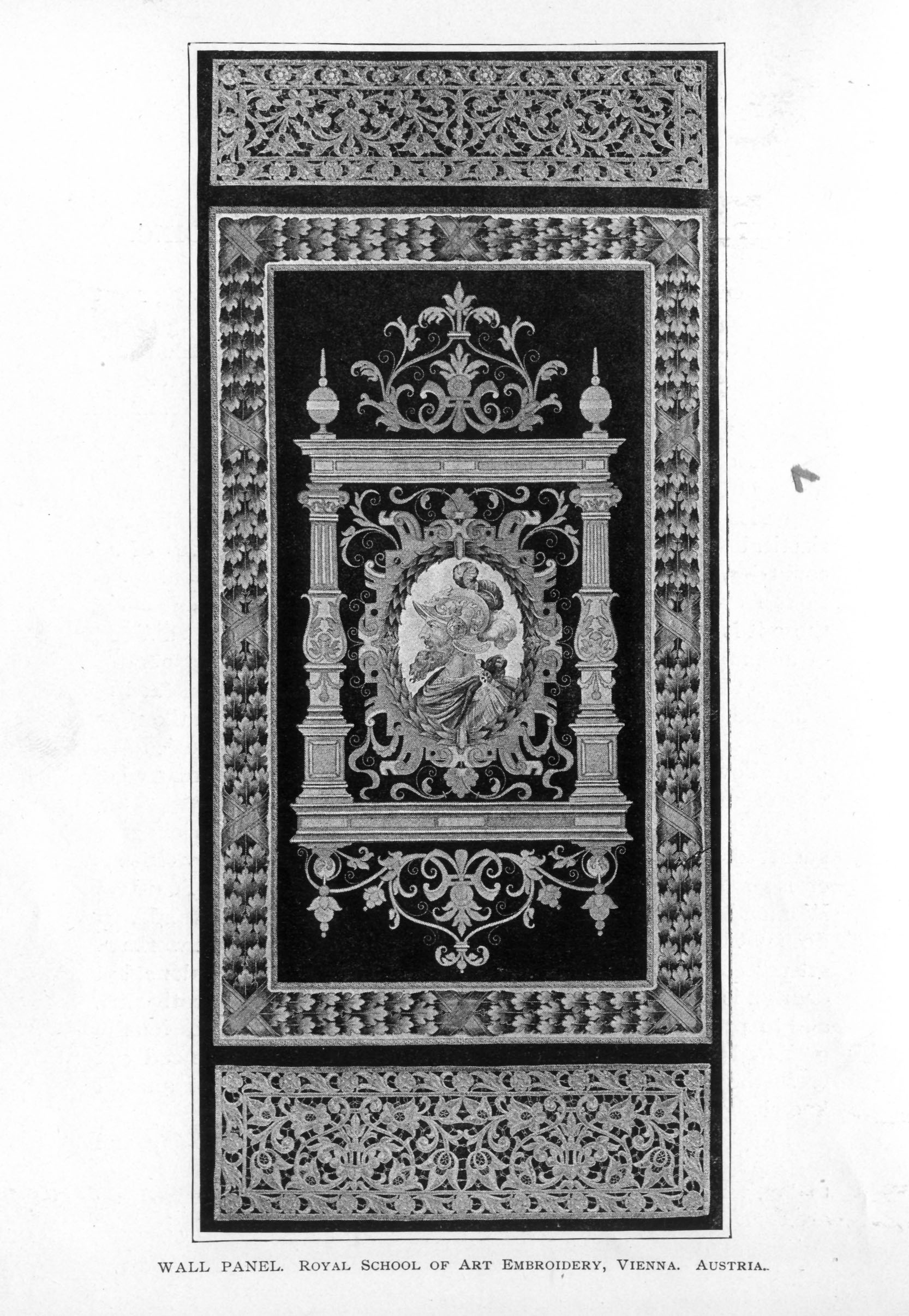
WALL PANEL.
ROYAL SCHOOL OF ART EMBROIDERY, VIENNA. AUSTRIA.

of a continuous exercise of them; and not only a revival, but an adaptation of them to new circumstances. Some of these arts had been practically dead for a hundred years. This consideration, while accounting for less exact execution, adds interest to the subject in showing the greater breadth given to every form of art by the modern diffusion of wealth, and possible gratification of taste in the individual. While the variety of direction is narrowed by the exhibits being exclusively the work of women, enough in all lines is shown to cause surprise even in this particular; since few are aware how much artistic labor is performed by women in the new directions of designing, cutting, leading, and painting of stained glass, of designs for book-making, both covers and illustrations; of designs for textiles and wall-hangings, drawing and modeling for silver-work, and in many other directions absolutely new to women. This is seen not only in the American Section, but in those of England, France, and Germany.
Those who believe in the application of the broadest and most thorough art-knowledge to mechanical processes have looked forward with apprehension to a collection of the work of women offered for competition and for the inspection of an art-loving world.
The exhibits of the Woman's Building are, however, entirely reassuring, and go to show, not only that art is a heritage common to both man and woman, but that both general and particular study have gone to the accomplishment of fine results. In examples of stained glass it is especially noticeable that simplicity and strength characterize the exhibits, and that the necessities and advantages of the art are well understood. Very few of the examples suggest the amateur gloss of the woman painter; in fact the most of it shows the result of careful study in a special direction, and an intention of mastery of the art as a profession. Certainly no one looking at some of these beautiful examples would characterize them as effeminate or weak. They are shown in a pavilion in the American Section, as well as in the Assembly Room, the California Room, and the Record rooms.
The embroidery exhibited by the Societies of Decorative Art and the Exchanges from many of our cities is of so high an order, that even those most familiar with the subject can hardly fail to be surprised with the very large amount of first-rate work exposed. There is no single specimen of embroidery which proves more conclusively that needlework is a form of artistic expression than the very remarkable piece of ecclesiastical embroidery, from that wonderful design of William Blake's, illustrating the lines: " When
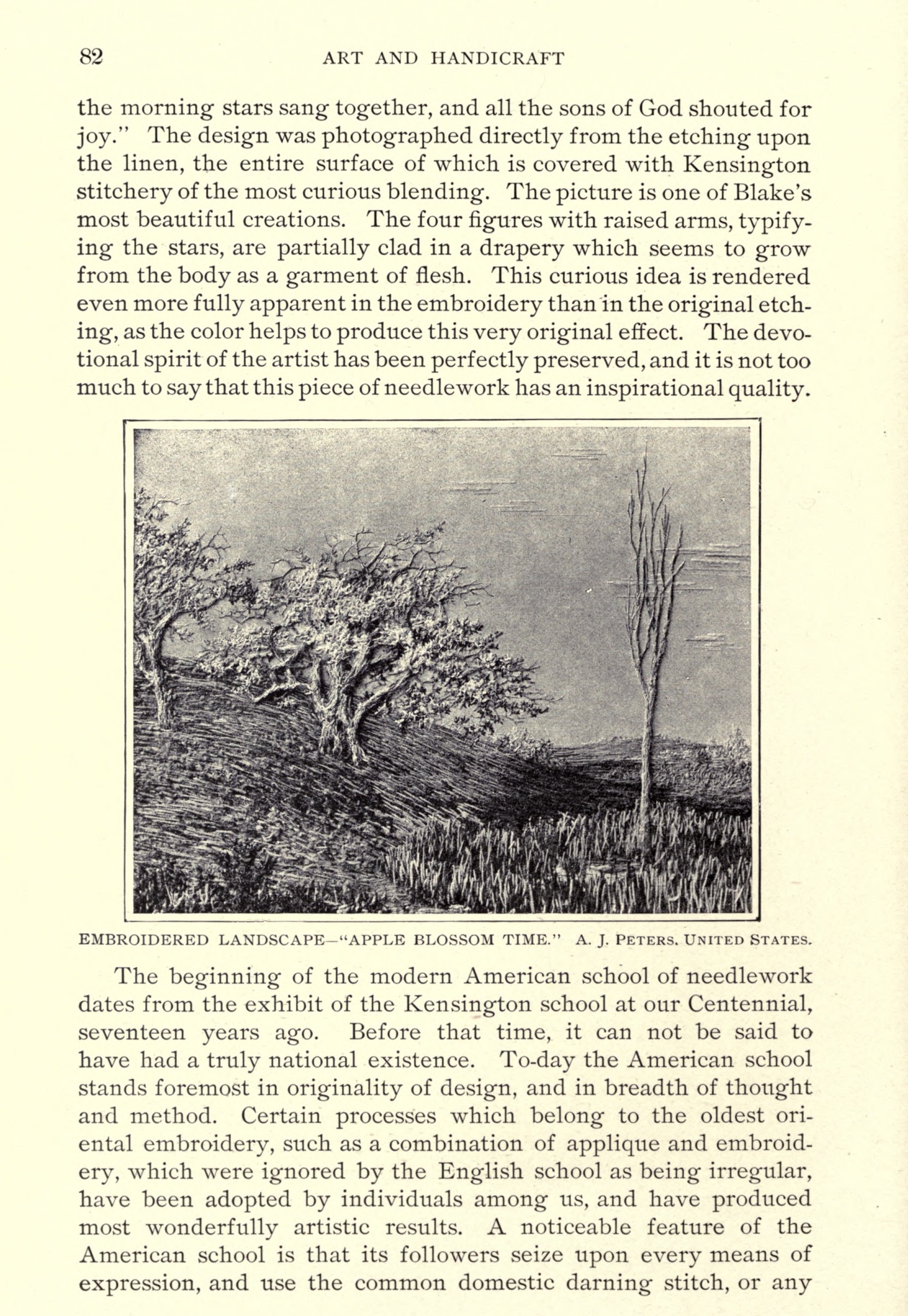
EMBROIDERED LANDSCAPE—"APPLE BLOSSOM TIME."
A. J. PETERS.
UNITED STATES.
the morning stars sang together, and all the sons of God shouted for joy." The design was photographed directly from the etching upon the linen, the entire surface of which is covered with Kensington stitchery of the most curious blending. The picture is one of Blake's most beautiful creations. The four figures with raised arms, typifying the stars, are partially clad in a drapery which seems to grow from the body as a garment of flesh. This curious idea is rendered even more fully apparent in the embroidery than in the original etching, as the color helps to produce this very original effect. The devotional spirit of the artist has been perfectly preserved, and it is not too much to say that this piece of needlework has an inspirational quality.
The beginning of the modern American school of needlework dates from the exhibit of the Kensington school at our Centennial, seventeen years ago. Before that time, it can not be said to have had a truly national existence. To-day the American school stands foremost in originality of design, and in breadth of thought and method. Certain processes which belong to the oldest oriental embroidery, such as a combination of applique and embroidery, which were ignored by the English school as being irregular, have been adopted by individuals among us, and have produced most wonderfully artistic results. A noticeable feature of the American school is that its followers seize upon every means of expression, and use the common domestic darning stitch, or any
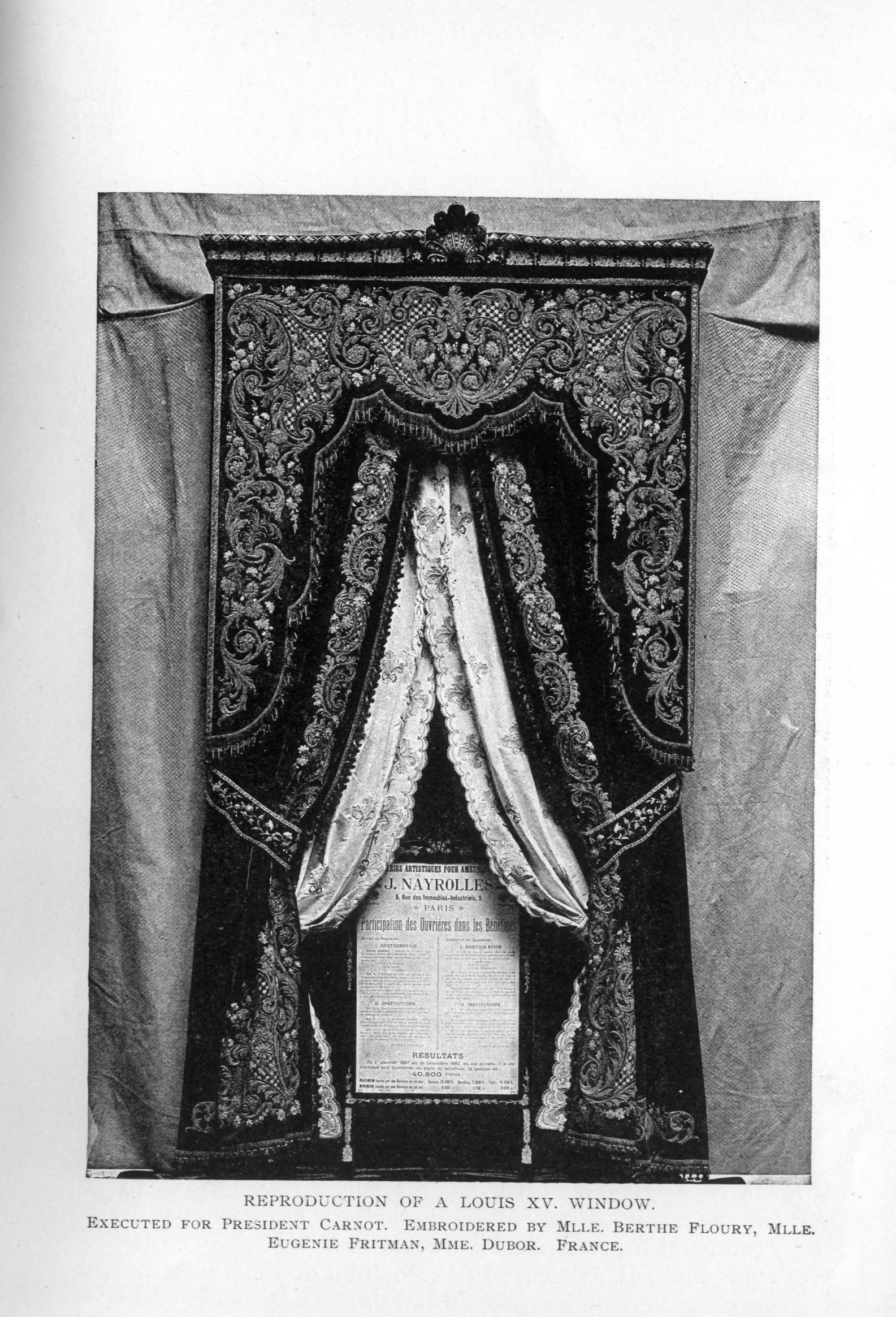
REPRODUCTION OF A LOUIS XV. WINDOW.
EXECUTED FOR PRESIDENT CARNOT.
EMBROIDERED BY
MLLE. BERTHE FLOURY, MLLE. EUGENIE FRITMAN, MME. DUBOR. FRANCE.

DESIGN FOR CARPET.
LUCY W. VALENTINE.
UNITED STATES.
other needlework stitch, to produce a desired effect; very much as a sculptor may pick up and use any bit of wood, or his own thumb, as a modeling tool, rather than the neatly turned instruments of his trade.
The color sense which distinguishes our people is found as much in the embroiderers as with the painters. Both the English and our own embroiderers surpass the European and the orientals in this respect. As far as pure technique goes, the Turkish Compassionate Fund shows the best work exhibited. The workers have the advantage of the inherited skill, which surpasses all other, and are directed in the use of color by English taste. Sweden sends us some fine examples, and France shows admirable work, but it is among our own women that we find the highest grade of embroidery. The productions of the Americans are scholarly, but not academic. They are full of fresh originality, and the motto of our needlewomen seems to be that they must use the rules that have heretofore governed their art, but that they must not be hampered by them in their own fresh, spontaneous growth.
In the great American revival of stained glass, our women are doing much creditable work. Many of the best firms, including that of Tiffany, employ women designers, who have met with very great success. Fifteen years ago, no American manufacturer thought of buying an American design for his carpet, or wallpaper, or textile. The usual thing to do was to buy a yard of French or English material, and reproduce its color and design. To-day the manufacturers all agree that the most popular designs they can furnish are made by our native designers, who are, to a very large extent, women. In the exhibit of the Pratt Institute,
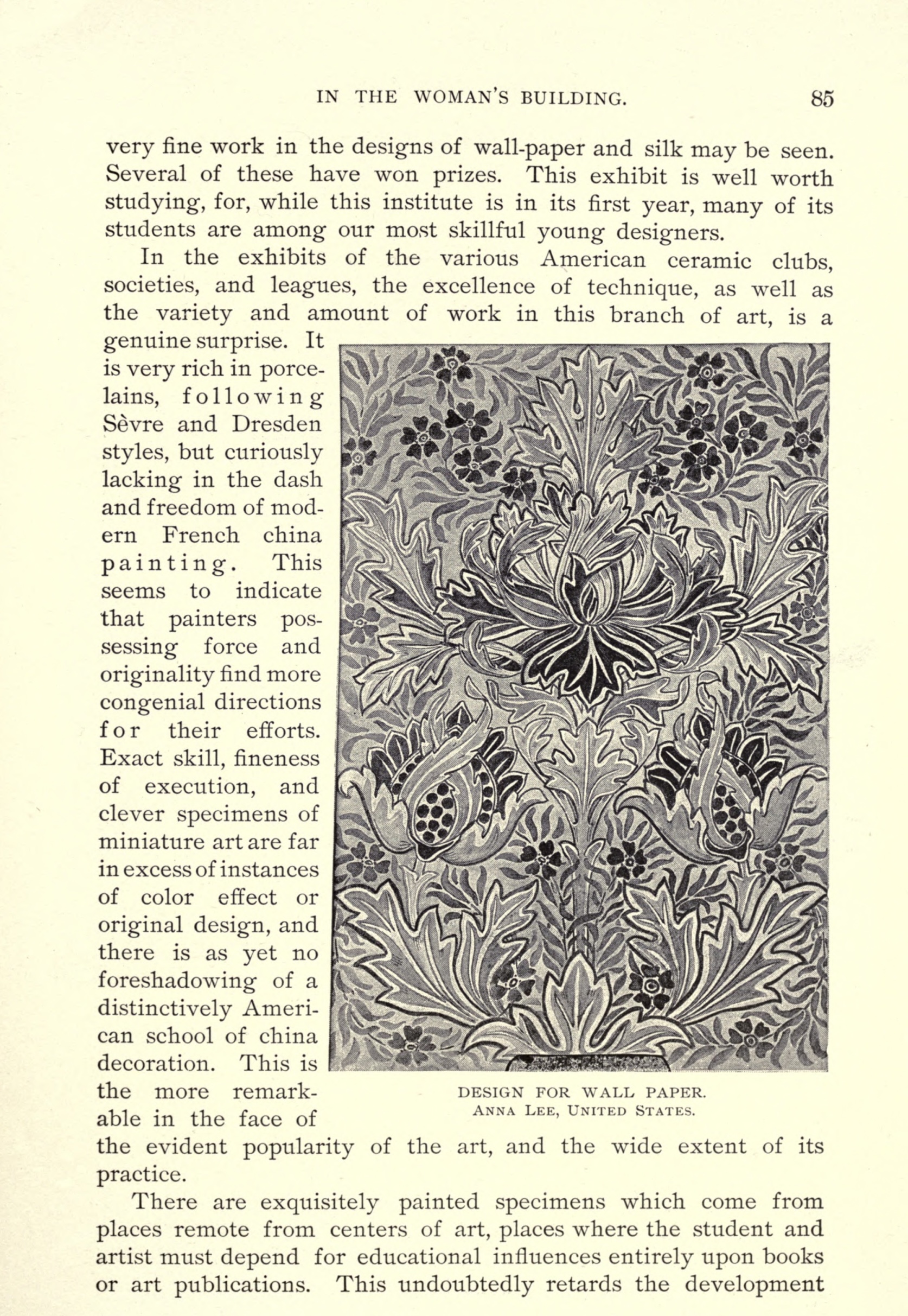
DESIGN FOR WALL PAPER.
ANNA LEE.
UNITED STATES.
very fine work in the designs of wall-paper and silk may be seen. Several of these have won prizes. This exhibit is well worth studying, for, while this institute is in its first year, many of its students are among our most skillful young designers.
In the exhibits of the various American ceramic clubs, societies, and leagues, the excellence of technique, as well as the variety and amount of work in this branch of art, is a genuine surprise. It is very rich in porcelains, following Sèvre and Dresden styles, but curiously lacking in the dash and freedom of modern French china painting. This seems to indicate that painters possessing force and originality find more congenial directions for their efforts. Exact skill, fineness of execution, and clever specimens of miniature art are far in excess of instances of color effect or original design, and there is as yet no foreshadowing of a distinctively American school of china decoration. This is the more remarkable in the face of the evident popularity of the art, and the wide extent of its practice.
There are exquisitely painted specimens which come from places remote from centers of art, places where the student and artist must depend for educational influences entirely upon books or art publications. This undoubtedly retards the development
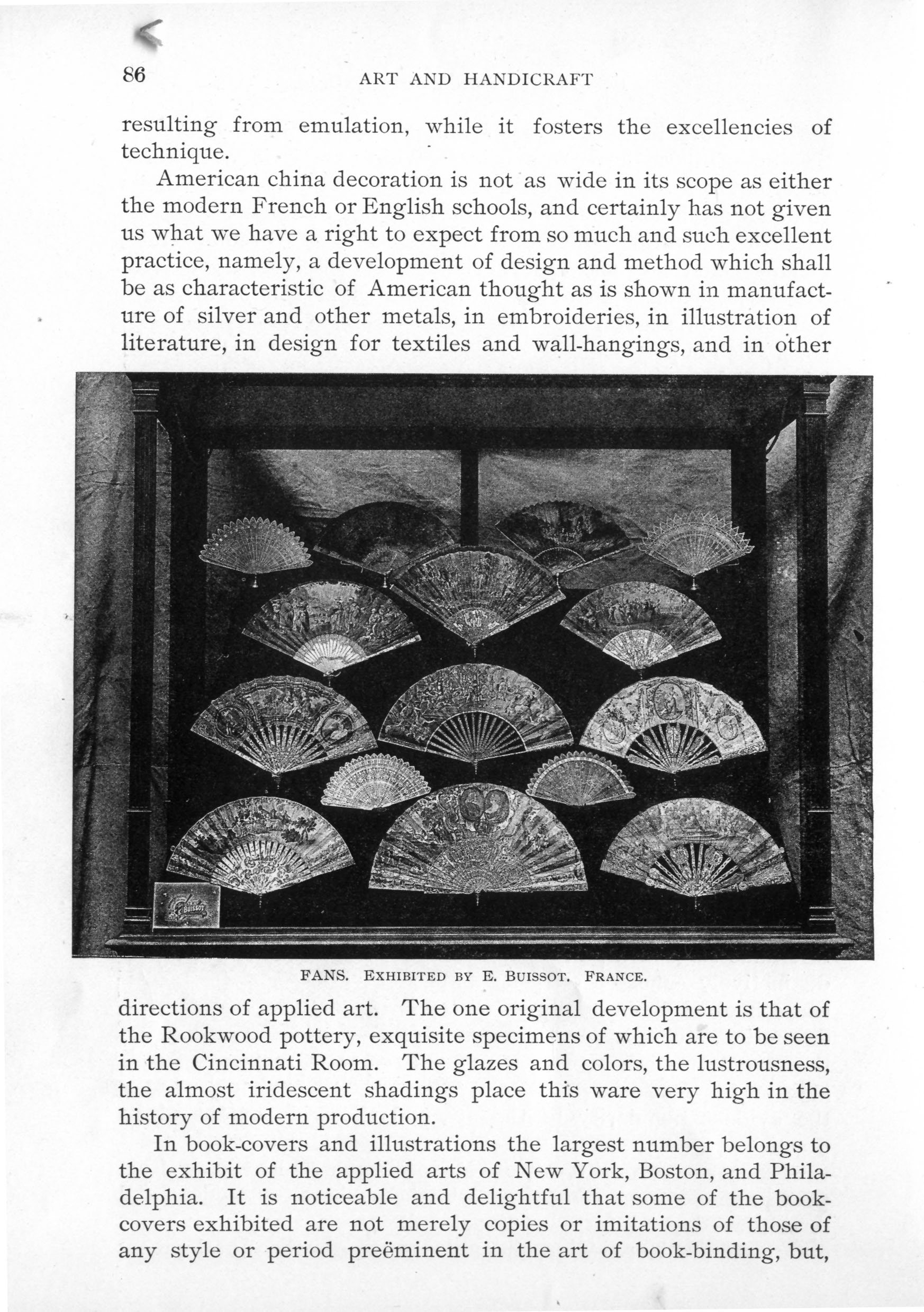
FANS.
EXHIBITED BY E. BUISSOT.
FRANCE.
resulting from emulation, while it fosters the excellencies of technique.
American china decoration is not as wide in its scope as either the modern French or English schools, and certainly has not given us what we have a right to expect from so much and such excellent practice, namely, a development of design and method which shall be as characteristic of American thought as is shown in manufacture of silver and other metals, in embroideries, in illustration of literature, in design for textiles and wall-hangings, and in other directions of applied art. The one original development is that of the Rookwood pottery, exquisite specimens of which are to be seen in the Cincinnati Room. The glazes and colors, the lustrousness, the almost iridescent shadings place this ware very high in the history of modern production.
In book-covers and illustrations the largest number belongs to the exhibit of the applied arts of New York, Boston, and Philadelphia. It is noticeable and delightful that some of the bookcovers exhibited are not merely copies or imitations of those of any style or period preëminent in the art of book-binding, but,
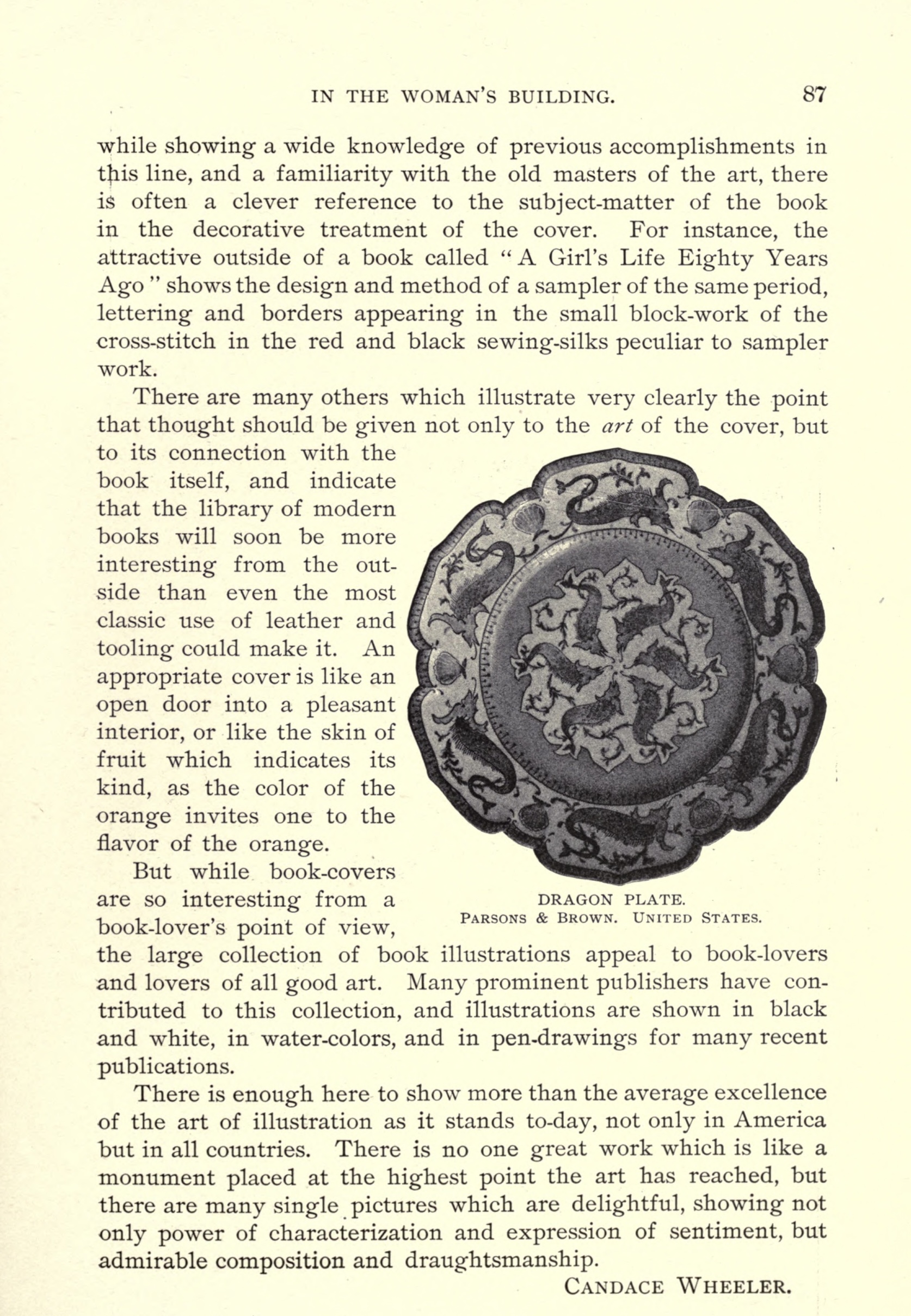
DRAGON PLATE.
PARSONS & BROWN.
UNITED STATES.
while showing a wide knowledge of previous accomplishments in this line, and a familiarity with the old masters of the art, there is often a clever reference to the subject-matter of the book in the decorative treatment of the cover. For instance, the attractive outside of a book called "A Girl's Life Eighty Years Ago" shows the design and method of a sampler of the same period, lettering and borders appearing in the small block-work of the cross-stitch in the red and black sewing-silks peculiar to sampler work.
There are many others which illustrate very clearly the point that thought should be given not only to the art of the cover, but to its connection with the book itself, and indicate that the library of modern books will soon be more interesting from the outside than even the most classic use of leather and tooling could make it. An appropriate cover is like an open door into a pleasant interior, or like the skin of fruit which indicates its kind, as the color of the orange invites one to the flavor of the orange.
But while book-covers are so interesting from a book-lover's point of view, the large collection of book illustrations appeal to book-lovers and lovers of all good art. Many prominent publishers have contributed to this collection, and illustrations are shown in black and white, in water-colors, and in pen drawings for many recent publications.
There is enough here to show more than the average excellence of the art of illustration as it stands to-day, not only in America but in all countries. There is no one great work which is like a monument placed at the highest point the art has reached, but there are many single pictures which are delightful, showing not only power of characterization and expression of sentiment, but admirable composition and draughtsmanship.
CANDACE WHEELER.

WATER-COLOR—DECORATIVE PANEL.
MADELAINE LEMAIRE.
FRANCE.